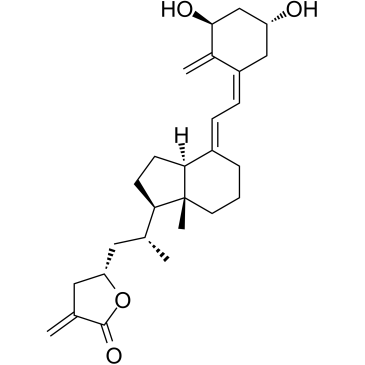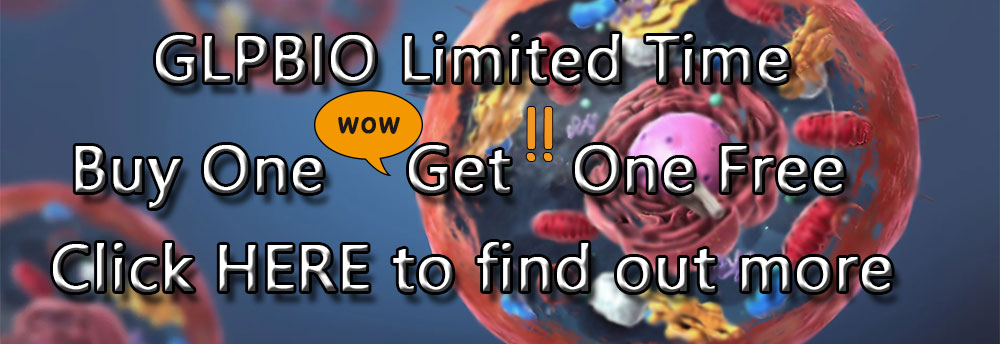TEI-9647 |
| Katalog-Nr.GC61768 |
TEI-9647, ein Vitamin-D3-Lacton-Analogon, ist ein potenter und spezifischer Antagonist des Vitamin-D-Rezeptors (VDR).
Products are for research use only. Not for human use. We do not sell to patients.

Cas No.: 173388-20-0
Sample solution is provided at 25 µL, 10mM.
TEI-9647, a Vitamin D3 Lactone analogue, is a potent and specific vitamin D receptor (VDR) antagonist. TEI-9647 inhibits VDR/VDRE-mediated genomic actions of 1α,25(OH)2D3. TEI-9647 inhibits bone resorption and HL-60 cell differentiation induced by of 1α,25(OH)2D3. TEI-9647 has the potential for suppressing the excessive bone resorption and osteoclast formation in Paget’s disease[1][2][3].
TEI-9647 (100 nM; 24 hours) treatment clearly suppresses p21WAF1,CIP1 gene expression induced by 1α,25(OH)2D3[1].TEI-9647 (10-1000 nM; 96 hours) dose-dependently blocks the reciprocal changes of CD11b and CD71 expression associated with HL-60 cell differentiation induced by 1α,25(OH)2D3. TEI-9647 completely blocks the increase in CD11b and the decrease in CD71 expression at 100 nM[1]. TEI-9647 blocks both 1α,25(OH)2D3-mediated HL-60 cell differentiation and also activation of the luciferase reporter in COS-7 cells that has been transfected with the cDNA containing the DRE of the rat 25(OH)D3-24-hydroxylase gene and cDNA of the human vitamin D nuclear receptor[1].TEI-9647 can not induce cell differentiation even after treatment at 1 μM in HL-60 cell. TEI-9647 alone can not induce activation of NBT-reducing activity or α-NB esterase activity. In contrast, TEI-9647 markedly suppresses the up-regulation induced by 1α,25(OH)2D3 (0.1 nM) in HL-60 cells[1]. TEI-9647 (0.001-1 μM; for 10 days) dose-dependently inhibits bone resorption induced by of 1α,25(OH)2D3 (1 nM). TEI-9647 alone never induces bone resorption even at 1 μM[2]. TEI-9647 (10 nM; 12 h) markedly inhibits TAFII-17 and 25-OH-D3-24-hydroxylase gene expression induced by 1α,25(OH)2D3 (0.1 nM) in bone marrow cells[2]. RT-PCR[1] Cell Line: HL-60 cells
[1]. Miura D, et al. Antagonistic action of novel 1α,25-dihydroxyvitamin D3-26, 23-lactone analogs on differentiation of human leukemia cells (HL-60) induced by 1α,25-dihydroxyvitamin D3. J Biol Chem. 1999 Jun 4;274(23):16392-9. [2]. Seiichi Ishizuka, et al. Vitamin D antagonist, TEI-9647, inhibits osteoclast formation induced by 1α,25-dihydroxyvitamin D3 from pagetic bone marrow cells. J Steroid Biochem Mol Biol. 2004 May;89-90(1-5):331-4. [3]. Kazuya Takenouchi, et al. Synthesis and structure-activity relationships of TEI-9647 derivatives as Vitamin D3 antagonists. J Steroid Biochem Mol Biol. 2004 May;89-90(1-5):31-4.
Average Rating: 5 (Based on Reviews and 38 reference(s) in Google Scholar.)
GLPBIO products are for RESEARCH USE ONLY. Please make sure your review or question is research based.
Required fields are marked with *




